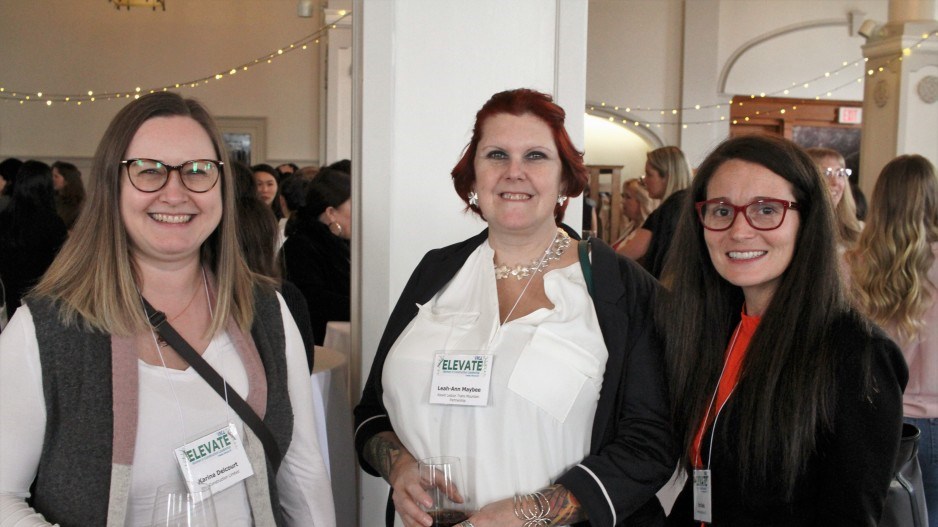When mentor and mentee Erin Deck and Leah Ann Maybee from Kiewit met for their first one-on-one session together, they say it felt as though they had known each other for most of their lives.
Maybee is one of many women in the construction industry who say they have benefited from the support of a female mentor.
“These mentorship programs are so important because a lot of women shy away from construction. They don’t know that there’s support available for them, because it’s still a male-dominated industry,” said Maybee.
In many instances, women in construction may be the only ones in their class or training school, or the only woman on a job site. As a result, “they’re very isolated,” said Karen Dearlove, executive director for the BC Centre for Women in the Trades (BCCWITT).
Initiatives like mentorship programs have been a valuable way to help women in the industry feel supported and uplifted, according to Deck.
“We need support from not just women, but men, and also transgender people and everyone that wants to be involved. Our progress and our performance has to speak for itself, but we need the support of everybody, not just the women to get further,” Deck said.
Women account for only 5.7 per cent of the construction trade workforce across 26,262 construction companies in the province, according to the British Columbia Construction Association (BCCA). Investments that support workforce diversification can help industry address the labour shortage facing it, says Vancouver Regional Construction Association (VCRA) president Donna Grant.
Approximately four out of five construction companies in B.C. report that they didn’t have enough workers as of January 2023, according to the Independent Contractors and Businesses Association. As a result of this trend, 5,653 construction jobs in B.C. will be unfilled by 2027, in addition to the 27,630 jobs that will become vacant due to retirements before that time, according to BCCA.
“If you’re looking at a labour shortage, and you’ve got another 50 per cent of the population to draw from that you’re not currently drawing from successfully, that’s a pretty nice well,” said Grant. “People who maybe hadn’t been as encouraging about enticing women into the industry, they’re far more motivated.”
“The glass ceiling has been smashed. Women are there but we just need to make sure that we’re still encouraging women in greater numbers to come in the industry,” she added.
The VRCA recently hosted a women in construction leadership event attended by around 180 women from a wide variety of trades and positions. Cheryl Nelms, general manager of project delivery at Metro Vancouver, said that such events are critical to bringing women in construction together.
Recruitment for women and other gender minorities within construction starts with educating young people, said Debbie Johansen, director of construction at Ledcor Property Investments.
“I don’t know if, within schools, they’re really doing a good job of promoting females in construction. Whether it’s support jobs, project management, or in the trades, I think that we could probably do a better job of that, starting at the high school level,” she said.
Many of those who spoke to Glacier Media highlighted the need to have conversations with young adults to educate them on the opportunities of working in construction, and to dispel stereotypes surrounding the industry. Companies need to consider how they engage younger generations, said Caroline Andrewes, president and CEO at Association of Consulting Engineering Companies.
“It’s not just about saying: ‘You should do engineering, it’s a really great career, you get paid very well.’ It’s more about thinking about how – how do people attach to their profession,” she said.
Communicating the creative aspects of many industry jobs – and how such roles can impact communities and the environment – can help attract talent. Ensuring corporate recruitment processes are tailored to that talent can also help the industry attract more women to the field, said Dearlove.
“It’s the language you use, taking a look at your requirements to see whether there are ways that you can talk about transferable skills,” BCCWITT’s Dearlove said. “Because a lot of people that are starting to get into the trades, a lot of women and other underrepresented groups, don’t necessarily feel like they have the same opportunities, because they don’t have the same background perhaps as men traditionally do in a lot of these cases.”
Her organization launched the Be More Than A Bystander program to help redefine construction workplaces, and make them more attractive to female workers. The program equips participants with tools and strategies to intervene in situations of bullying, harassment and violence.
“It’s about creating respectful workplaces, but more than anything, making everybody in the workplace, especially the men who are the majority of the workers, responsible for creating a good workplace culture,” she said.



